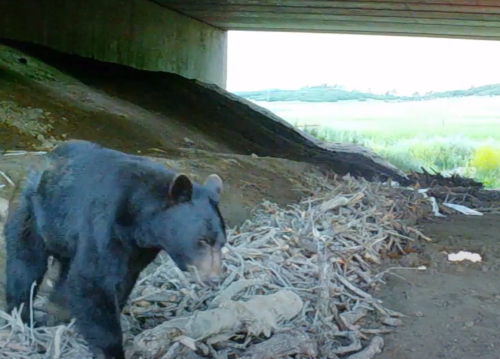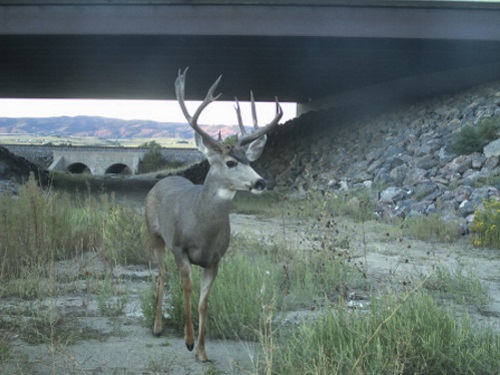The Colorado Department of Transportation and the Colorado Parks and Wildlife (CPW) agencies recently completed wildlife underpasses along a rural stretch of Interstate 25 between Colorado’s two largest cities, Denver and Colorado Springs.
[Above photo by the Colorado DOT]
This wildlife mitigation system is part of a $419 million transportation improvement project – known as the I-25 South Gap project – that aims to improve safety and travel on 18 miles of I-25 south of the Denver metropolitan region; a route that more than 87,000 motorists use on a daily basis.
The I-25 South Gap project’s wildlife mitigation system includes four new and one refurbished wildlife underpasses, 28 miles of deer fencing, and deer guards and jump-outs, Colorado DOT said.
Work on the underpasses is substantially complete with 8 percent of deer fencing installed – just in time to shepherd migrating wildlife safely under the interstate this fall. The I-25 South Gap project as a whole, however, should be finished by 2022, the agency noted.
The Colorado DOT and CPW are also now in the process of installing 59 cameras throughout the project’s wildlife mitigation system to help measure success.
Shoshana Lew, executive director of the Colorado DOT, said that these wildlife underpasses – used by bears, elk, and small game animals – are also some of the largest in North America.
“One of [our] core values is safety, and we are thrilled to deliver on this value to all who use I-25 in the area,” she explained in a statement.
“In Colorado, nearly 4,000 animal-vehicle crashes are reported annually, resulting in injuries and fatalities to people and costing an estimated $80 million,” Lew added. “In the I-25 South Gap, it is estimated that one animal-vehicle crash occurs per day. Our wildlife mitigation system aims to reduce these crashes by 90 percent.”

“Colorado DOT met with various agencies, including CPW, early in the planning process to come up with a collaborative solution,” noted Brandon Marette, land use coordinator for CPW’s Northeast Region. “Fast forward from our first collaboration meeting nearly five years ago to today, where wildlife is now using the underpasses that we planned together. There is more collaboration to come between our agencies as we continue to plan and implement strategies to keep both people and wildlife species safe, thus protecting what is unique to Colorado.”
State departments of transportation in various parts of the country have been working on ways to improve wildlife mitigation tactics over the past several years.
In 2019, the Pew Trusts issued a report that highlighted the work states are doing to boost safe passage for wildlife around roadways, while at the same time improving motorist safety.
“Big-game animals in the American West today are increasingly squeezed by growing suburban areas, energy development, climate change, and an expanding road network,” noted Matt Skroch, a manager with the Pew Charitable Trusts’ U.S. public lands and rivers conservation team and author of the report, at the time.
“[Those] factors are threatening the landscape connections that wildlife needs to move to and from their seasonal feeding and breeding grounds,” he added. “To conserve wildlife corridors while reducing wildlife-vehicle collisions in the West, state and local governments need to take the lead on these issues and guide their agencies to effectively link science with policy. Fortunately, this is beginning to happen. From Montana to New Mexico, states are identifying hot spots where collisions occur and linking those areas with the larger habitat conservation needs on either side of the road.”
For example, in April, the construction of the new Rock Creek Bridge to replace a culvert on US-20 recently won an engineering excellence award from the American Civil Engineers Council of Idaho – an award shared by the Idaho Transportation Department (ITD) and Jacobs Engineering. That new bridge now allows wildlife to pass under the highway, reducing the risk of possible collisions involving wildlife and vehicles on the roadway.
The ITD added in a statement that this particular section of US-20 witnessed 64 vehicle-wildlife collisions over the last five years, which totals a “societal cost” of approximately $2 million when adding together the cost of vehicle repair or replacement, medical bills, and increased insurance rates – not to mention the cost to wildlife.

